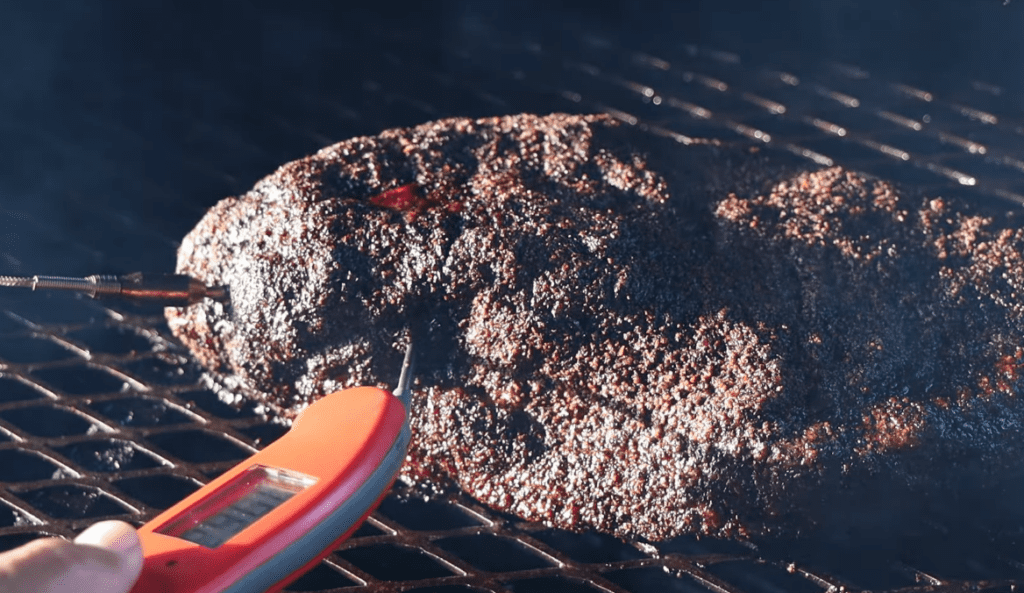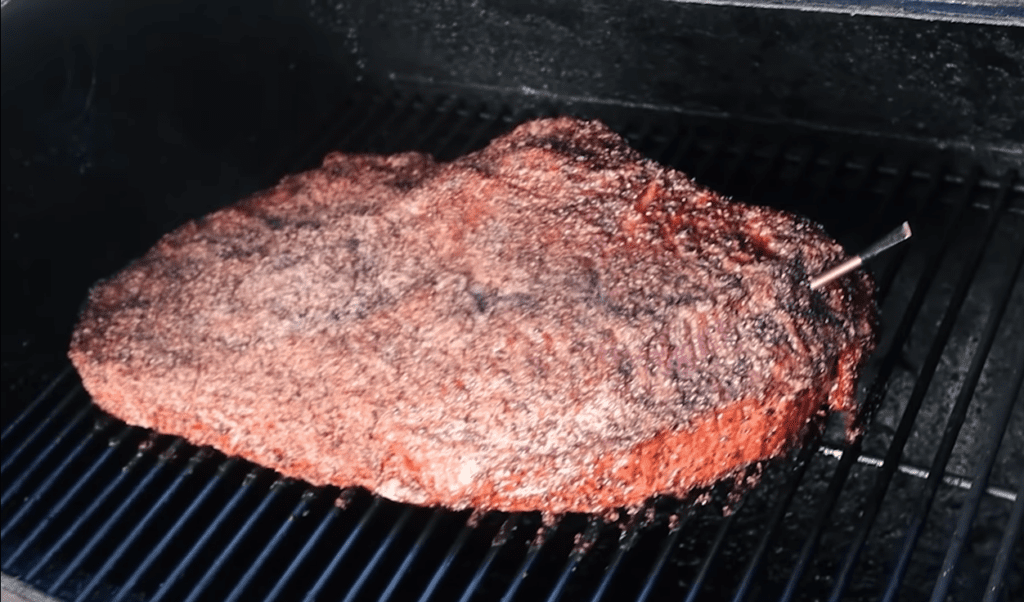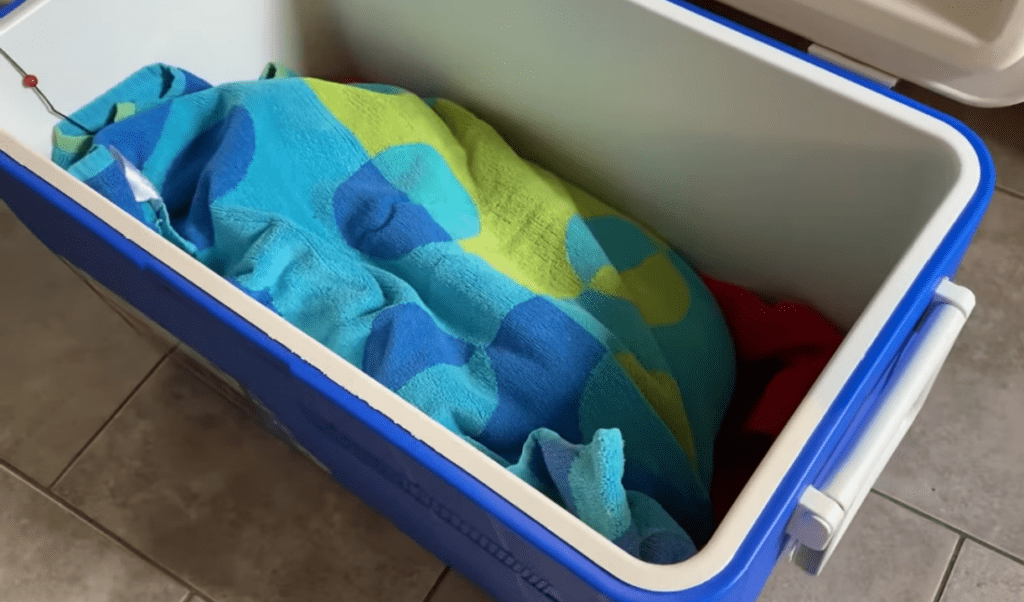Do you want to know at what temperature you can pull brisket off the smoker? The simple answer is, “as soon as a bamboo skewer, when probed, slides into it as if it were the refrigerated peanut butter or butter rested at room temperature.”
What? Have you been hearing that you can remove the brisket from the smoker at 195-203 internal temperature or even 210 degrees Fahrenheit internal temperature?
A big confusion: still, sometimes it can be left undercooked or even overdone.
The reason is that there are many details that you need to know to pull the brisket off the smoker when done fully. The reason is that not every brisket is the same, nor is your smoker type; like temperature, fluctuation is also not unpredictable during hours-long cooking events.
It’s why we’ve got you covered in this detailed article.
Below is the temperature detail to pull your brisket off the smoker that will help you cook your brisket successfully.
One thing you need to know before we begin is,
‘’It’s basically not concerned with the actual temp that a brisket is done at; rather, it’s more about the actual feel of the brisket.’’
So, let’s get into it…!
Parts of Brisket and Temperature Variations
A brisket is a big piece of meat located on the upper side of the cow’s front leg and is cut from the lower chest.
On a cow, it does a ton of work, and so there’s plenty of connective tissue (composed of collagen) that makes the meat tough. Cooking brisket with indirect heat helps to convert the collagen into gelatin.
The full brisket, usually called the packer brisket, consists of two muscles and a fat cap. The two muscles are commonly known as the flat and the point.
The flat is a leaner and meatier part and has connective tissues, fat in the form of marbling yet, still less. Therefore, it’s less resilient while cooking.
So, it requires a higher temperature to cook. Otherwise, it might get burned or dry out. The temp of 160 degrees Fahrenheit works well for flat to start rendering down collagen into gelatin, and the process continues for hours.
On the other half of the brisket is the point, also called deckle or deckel. It is thicker and contains more fat, marbling, and connective tissue. That’s why it requires a lower temperature of around 140 degrees Fahrenheit to render down for several hours.
As you can see, both parts have their specific temperature range at which they’re cooked.
For example, at an internal temperature of 160 F, the collagen can take more than 20 hours to render down so that it comes out moist.
Until all meta is fully rendered, during the course, your brisket can reach up to 195-210 degrees Fahrenheit.
Two Stages of Checking Brisket’s Internal Temperature

Before pulling a smoked brisket off a smoker, it’s necessary to understand the different stages before you lift it off the smoker.
So, here, we’ve discussed the brisket’s internal temperature at two stages:
- The stall stage (when you wrap the brisket.)
- When your brisket is ready.
1- The Brisket’s Stall Stage

When you cook brisket in the smoker, the stall stage is when it looks as if you have done the cooking. This point might create fear and intimidation, and so you should watch for this one.
The internal temp for brisket when it stalls is around 150 degrees F to above 170 F; the stall may last for 30 minutes to several hours.
This temperature can exist when you smoke your brisket at a lower internal temperature like 125 F and at 220 F or even more.
Lift the brisket when the stall hits temperature ranges of 165 – 175 and warp it in foil or butcher paper.
How will you know that the bark is well compact?
When you observe:
- The meat is tender, and the skin doesn’t jump off if push it gently;
- The crispy bark is of dark mahogany color;
- And, if scratched with the knife’s blunt side, the crackling sound is audible.
You might also notice the brisket’s texture will be sticky. Moreover, the juices dripping over the browned skin will increase your appetite and will make your mouth water.
The heat level will come down as the meat will be in a process called evaporation.
One more thing you would want to remember is that brisket must be tender but not to the extent that it’s sinking apart.
2- The Time When Your Brisket is Ready for Removing from the Smoker.

Regarding the temp when you should pull brisket off the smoker, there’s no accurate answer because each pit master has his own opinion.
When the stall stage is done, you wrap the brisket and return it to the smoker to get a nice and moist brisket. Now you need to know the exact temperature you should aim for.
It is said that the ideal temperature is between 195 degrees Fahrenheit to 210 degrees Fahrenheit. Yet, it’s only the temperature range where the brisket can be pulled off the smoker, and the exact temperature lies anywhere between when the brisket is fully done according to the bamboo skewer or probe test.
It’s why experts might feel like pulling their brisket off the smoker at different temperatures during this range.
Should you pull your brisket at 195 degrees Fahrenheit?
Particularly, at 195°F, pulling your brisket off the smoker is a bit of a dangerous decision. This range of temperature can risk undercooking it.
The reason is that all the fat and collagen of connective tissue do not convert into gelatin at this temperature, resulting in a slice of less tender and moist meat.
Should you pull your brisket at 210 degrees Fahrenheit?
Similarly, if you pull the brisket at 210°F of internal temperature, you might regret your decision because it can get overcooked, and you’ll have to serve a dry and chewy brisket.
Total regret!
Therefore, it is suggested to pull the brisket off the smoker that has touched the temperature of 200 degrees Fahrenheit to ensure you get the succulent and juicy brisket. Yet, it might work oddly in some cases.
So, What’s the Best Internal Temp to Pull the Brisket Off?
It’s not the temperature but the temperature range of 195-210 degrees. The brisket can be ready at any temperature from this range, and that exact temperature only depends on the individual brisket.
When slow cooking the brisket, you have the right spot in terms of doneness, and you can test it by doing a brisket doneness test. You can do so by starting to check the brisket when the internal temperature reaches 195 degrees in the flat muscles’ thickest part.
Will it be cooked at 195, 203, 205, or 210? Every expert will have their own opinion! For example, Aaron Franklin considers 195°F the best internal temperature.
For some pros, 202 F is ideal. Whereas some experts have claimed that the best temp. for removing the brisket is between 180 F and 190 F.
Still, the preferred internal temperature for brisket is 195 degrees Fahrenheit to 203 degrees Fahrenheit. Many recipes also consider 203 degrees Fahrenheit as the foolproof temperature.
So, to get the nice and flavorful brisket, start checking your brisket at 195 F, and when the temperature reaches 200 F – 203 F, you can remove your brisket from the smoker.
To watch the internal temp, it is suggested to keep a high-quality instant-read thermometer at your grilling station.
This might be the most critical step, so you must ensure that your meat probe is accurate.
How to Test if your Brisket is Ready to Pull Off the Smoker?
As discussed above, every brisket is different, and you can’t tell if the brisket is ready by simply recording the temperature in the flat area in the 195-210 range, except by doing the test. So, “how to tell if a brisket is done?” In this regard, you should check your brisket as mentioned below.
Test: 1 – Go by Feel
It’s one of the simplest methods to check if your brisket is ready to move on to the next step of resting or not.
Grab a pair of cotton or nitrile gloves and wear them to avoid getting your hands burned.
Now, put your fingers under the brisket and lift it right from the center.
If the brisket feels like a big piece of gelatin, that’s the sign that it’s done.
Test: 2 – Probe test/ By Poking it

According to experts, this test is the most reliable because it works for all kinds of brisket.
Poking the meat with a bamboo skewer or probe is an effective method to check if the brisket is ready. You can do this test as soon as the temperature hits 195 F.
Proceed to insert the probe into the brisket. If it slides in and out of the meat without any resistance and the brisket feels smooth like room temperature butter, then it’s done. You can also insert the toothpick into the brisket, but it is less reliable because it is not much thicker.
You can also use the thermometer’s probe; if you don’t feel any pushback when sliding the probe, the brisket is done.
Test: 3 – The Fork test
You would also want to test your brisket in another way. This is the brisket fork test, and it is a great way to check your brisket readiness.
Grab a fork or any other hard material such as a knife and insert it into the brisket. If the brisket does not resist a change and allows it to slide, it has hit the right degree of tenderness.
How Long does it Take to Smoke your Brisket?
One average packer weighs about 11 – 18 pounds. Meathead Goldwyn, an American food writer and chef recommend smoking brisket at 225 degrees Fahrenheit.
So, how long will your brisket take?
At 225 F cooking temperature, it usually takes about 1.5 to 2 hours per pound of beef brisket to cook.
Various things can cause fluctuations during this time, like wind, temperature, smoker type, meat thickness, and how often you open the door of a smoker.
So, in the case of a brisket that weighs 12 pounds after trimming, it can take about 18 hours to cook when the temperature is around 225 F.
In the same way, at 275 degrees Fahrenheit, it takes 1 hour per pound of brisket. So it can take more than 12 hours for a brisket that weighs 14 pounds.
But, all briskets don’t have the same rate at which they’re cooked, even if their weights are equal. Thus, keeping a good thermometer at your grilling place is advisable.
Sometimes, the brisket attains the ideal temperature sooner, and sometimes it can take longer to cook based on the cut of meat and the dependability of the smoker.
How Can You Rest Your Brisket?

After discussing brisket internal and cooking temperatures in detail, not everything is done. Another crucial stage awaits you where you have to take care of your brisket’s internal temperature.
When your brisket meets the three tests mentioned above, you can take it off the smoker, but you’re not yet done.
Irrespective of the desired temperature, the temperature can increase to another 10 degrees after you remove it from the smoker. So, to get an internal temperature of 190°F, pull it off the smoker at 180°F.
To rest your brisket, you need to lift it off the smoker, unwrap it, and place it on any dish.
You can rest your brisket for several hours, from at least 2 to more than 8 hours.
Resting your brisket helps in:
- Sinking the moist particles
- Completing the rendering procedure of all the collagen and fat.
So resting your brisket is essential if you want to serve a properly smoked brisket.
What To Do if you have Pulled Brisket Early, by Mistake?
Meat smoking comes with many surprises. It can happen if you test the brisket temperature, probably in the brisket fat side known as a point (which will record higher temperature), and you pull it off the grill.
And you’re left depressed because you don’t want to ruin your big dinner. Don’t worry. The solution is there.
When you get the brisket out of the smoker, its internal temperature keeps rising, and the cooking process continues, and it can increase up to 10 degrees Fahrenheit, what we call carryover cooking. It gives you an edge in case of moving the brisket too early.
You can put the brisket to rest without cooling it at room temperature. In this way, the rising temperature will keep cooking your brisket inside the cooler for a longer time, and your brisket will be cooked.
Conclusion
Smoking a brisket may seem hard. But, once you master the techniques of when to pull brisket off the smoker and the smoked brisket temperature and time, you’re on your way to eating an appetizing meal.
universitygrill.net is a participant in the Amazon Associate program and will earn from qualifying purchases.
